Mausoleum of the Yellow Emperor: A Journey into China’s Legendary History
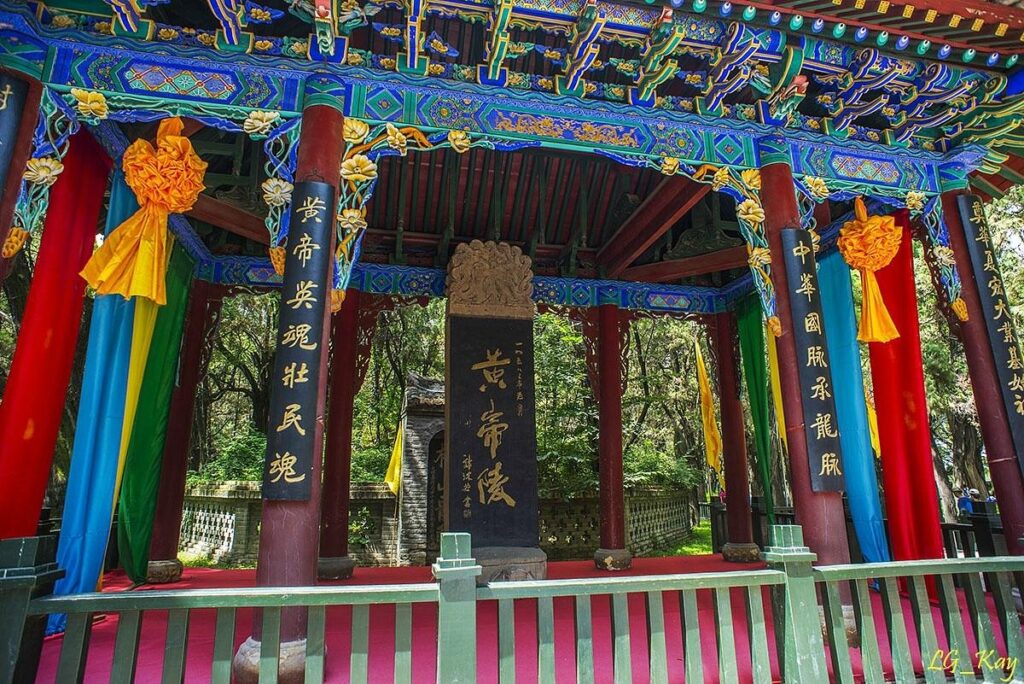
An Essential Guide to Visiting Mausoleum Of The Yellow Emperor
In This Guide
- An Essential Guide to Visiting Mausoleum Of The Yellow Emperor
- The Rich History and Legends of Mausoleum Of The Yellow Emperor
- Main Highlights: What You Absolutely Can’t Miss
- Planning Your Visit: A Practical Guide
- Tickets: Prices, Booking, and Tips
- How to Get There: A Complete Transportation Guide
- Local Cuisine and Accommodation Nearby
- Frequently Asked Questions
- Final Thoughts on Your Trip
Nestled in the serene landscapes of Lingbao, Henan Province, the Mausoleum of the Yellow Emperor (黄帝陵) stands as a testament to China’s rich historical tapestry and cultural heritage. Revered as the legendary ancestor of the Chinese people, the Yellow Emperor, or Huangdi, is a pivotal figure in Chinese history, credited with numerous inventions and the foundation of Chinese civilization itself. This mausoleum not only serves as a memorial to Huangdi but also as a symbol of unity and cultural roots for the Chinese nation.
As you approach the site, you will be greeted by ancient cypress trees, some over 5,000 years old, believed to have been planted by the Yellow Emperor himself. These magnificent trees whisper stories of a bygone era, setting the stage for your exploration. The mausoleum’s architectural style, reminiscent of the grandeur of the Roman Pantheon, offers a striking contrast to traditional Chinese structures, inviting you to reflect on the historical significance of this site.
Visitors will discover that the mausoleum complex is more than just a resting place; it is a place of reverence, where poetry and prayers intertwine with the legacy of the Yellow Emperor. The vast courtyard, echoing the majesty of Beijing’s Forbidden City, provides a breathtaking backdrop for contemplation and admiration. With its expansive views of the surrounding hills, the site evokes a sense of connection to the past and the roots of Chinese identity.
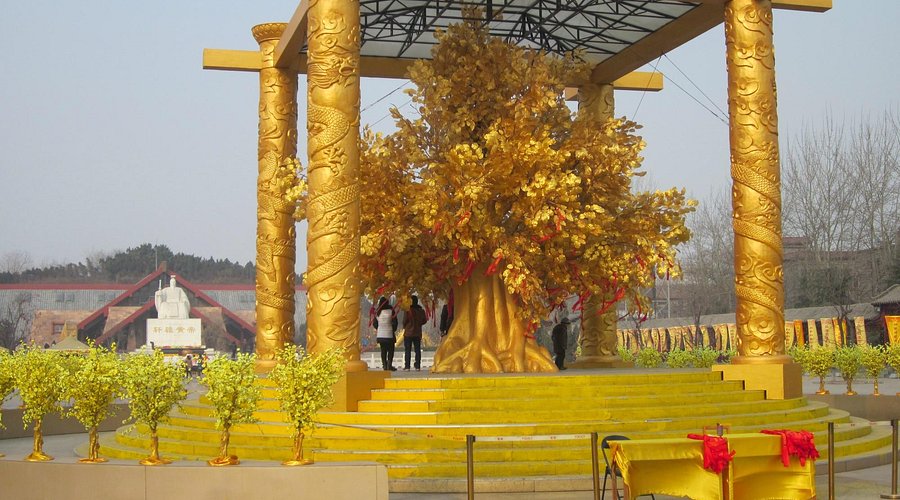
Mausoleum_Of_The_Yellow_Emperor.
Whether you’re a history enthusiast, a cultural explorer, or simply seeking a peaceful retreat into nature, the Mausoleum of the Yellow Emperor promises an enriching experience that transcends time. Prepare to embark on a journey through history, where the ancient and the modern converge in a celebration of China’s illustrious heritage.
The Rich History and Legends of Mausoleum Of The Yellow Emperor
The Mausoleum of the Yellow Emperor, located in Lingbao, Henan Province, is a testament to one of China’s most revered historical figures. Known as Huangdi (黄帝), the Yellow Emperor is often considered the progenitor of the Chinese nation and a symbol of Chinese cultural identity. His mausoleum stands as a significant site for both historical reflection and cultural reverence.
A Legendary Figure
The Yellow Emperor is shrouded in myths and legends that date back thousands of years. He is credited with numerous accomplishments that laid the foundations of Chinese civilization. According to legend, he united various tribes, developed traditional Chinese medicine, and is considered the inventor of various agricultural tools. His reign is often associated with the dawn of Chinese history, a period where the foundations of culture, philosophy, and governance were solidified.
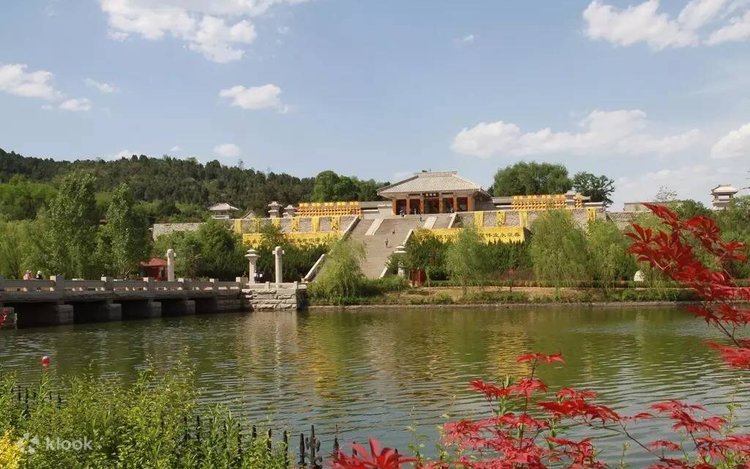
Mausoleum_Of_The_Yellow_Emperor.
Historical Significance
The mausoleum is believed to be the final resting place of Huangdi, who is thought to have died around 2597 BCE. Over the centuries, this site has become a pilgrimage destination for those seeking to honor the contributions of the Yellow Emperor. The Chinese government recognizes Huangdi as a critical figure in the search for national roots, which plays an important role in contemporary Chinese identity.
Architectural Marvel
The current structure of the mausoleum is a relatively modern construction, completed in the late 20th century, yet it draws inspiration from both Chinese and Western architectural traditions. Its grand entry courtyard rivals the expansive grounds of Beijing’s Forbidden City, with a unique design that emphasizes simplicity and grandeur. Visitors are often taken aback by the mausoleum’s dramatic layout, which includes a massive stone stele that features an inscription paying homage to the Yellow Emperor.
The Grounds
The mausoleum is set against a backdrop of stunning natural beauty, perched atop a hill surrounded by ancient cypress trees—some of which are said to have been planted by the Yellow Emperor himself. These magnificent trees, with one estimated to be over 5,000 years old, serve as silent witnesses to the site’s enduring significance.
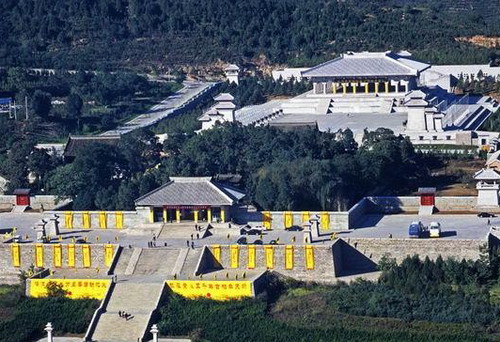
Mausoleum_Of_The_Yellow_Emperor.
As you explore the grounds, you will find several pavilions that house historical artifacts, poetry, and inscriptions that celebrate the Yellow Emperor’s legacy. These pavilions are not only places of remembrance but also spaces where visitors can connect with the past through rituals, such as burning incense to honor their ancestors and seek blessings for future generations.
Cultural Impact
The mausoleum is not just a historical site; it is a vibrant hub of cultural activity. It attracts visitors from across China and around the world, serving as a reminder of the rich tapestry of Chinese history. The site has been infused with elements of modern Chinese nationalism, often linking the Yellow Emperor to contemporary themes of unity and cultural pride in the face of globalization.
Visiting the Mausoleum
For those who wish to embark on a journey to this historical site, the mausoleum offers an enriching experience. It is advisable to spend a few hours exploring the area, taking in the serene landscape surrounding the mausoleum and contemplating the lasting impact of the Yellow Emperor on Chinese culture. Whether you are drawn by history, legend, or the sheer beauty of the site, the Mausoleum of the Yellow Emperor promises an unforgettable experience that resonates with the soul of China.
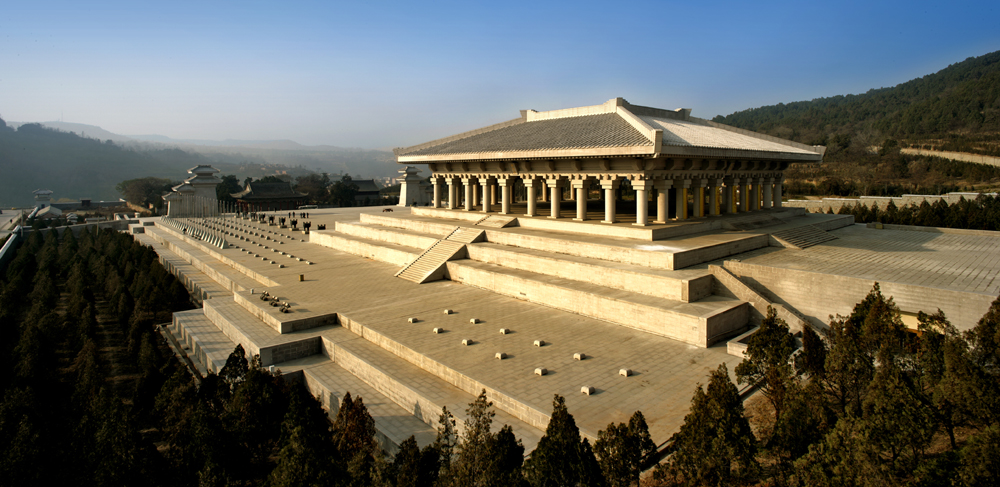
Mausoleum_Of_The_Yellow_Emperor.
Main Highlights: What You Absolutely Can’t Miss
Main Highlights of the Mausoleum of the Yellow Emperor
Visiting the Mausoleum of the Yellow Emperor (黄帝陵) is not just a trip to a historical site; it’s an immersive journey into ancient Chinese culture and mythology. Nestled in the serene hills of Lingbao, Henan Province, this monument honors one of China’s most revered figures, the Yellow Emperor, who is believed to be the forefather of the Chinese nation. Here are the main highlights you absolutely cannot miss:
1. The Ancient Cypress Trees
Upon entering the grounds, you’ll be greeted by magnificent cypress trees—some of the oldest living beings in the world. The 5,000-year-old tree, reputedly planted by the Yellow Emperor himself, stands proudly alongside another 3,500-year-old cypress that once served as a place to hang generals’ armor before battle. These trees are not only natural wonders but also significant symbols of resilience and history.
2. The Imposing Mausoleum Structure
The mausoleum itself is a recent architectural marvel, drawing inspiration from both the Pantheon in Rome and the austere buildings of Berlin. Its minimalist design emphasizes grandeur through sheer size rather than ornate decorations. The central feature is a 6-meter stone stele with an engraved representation of the Yellow Emperor, inviting visitors to reflect on the legacy of this iconic figure.
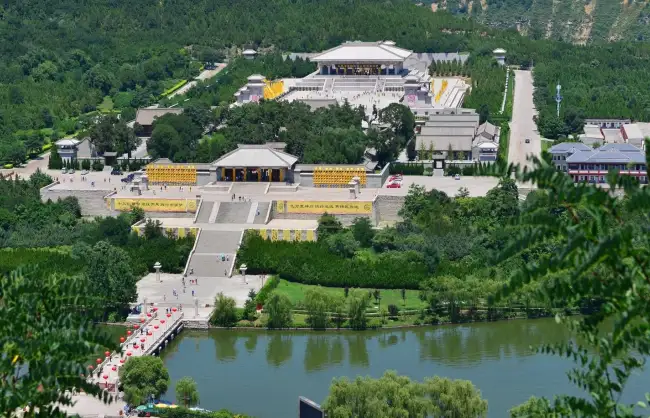
Mausoleum_Of_The_Yellow_Emperor.
3. Expansive Courtyard
The surrounding courtyard is as impressive as any found in Beijing’s Forbidden City, if not more so. Perched atop a hill, it stretches out majestically, unconfined by walls and offering breathtaking views of the distant hills. The courtyard is lined with yellow flags and adorned with huge metal urns, creating a cinematic atmosphere that transports you to ancient China.
4. Cultural Pavilions
Wander into the pavilions that house poetic tributes from both the Yellow Emperor and modern leaders like Mao Zedong. These spaces reflect the intertwining of ancient history with contemporary China’s narrative, especially as the Yellow Emperor symbolizes the modern Chinese search for cultural roots.
5. Incense Offering Pavilion
For an authentic experience, visit the incense offering pavilion. Here, you can purchase incense for a small fee (5 RMB) to pay homage to the Yellow Emperor and pray for prosperity for future generations. However, be cautious of persistent vendors who may attempt to upsell you on various items under the guise of spiritual offerings.
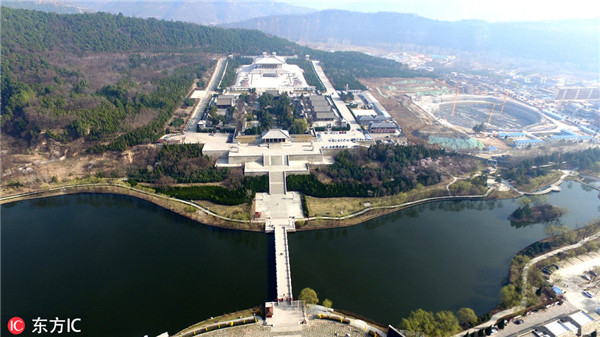
Mausoleum_Of_The_Yellow_Emperor.
6. Scenic Grounds and Lake
The broader grounds of the mausoleum offer a tranquil lake and plenty of space to explore. Take a leisurely stroll along the paths, breathe in the fresh air, and immerse yourself in the peaceful surroundings. This is a perfect spot for reflection or simply enjoying the beauty of nature.
7. Accessibility
While the mausoleum is easily accessible, visitors should be prepared for a short electric car ride (at an additional fee) to the tomb entrance, followed by a 15-minute walk uphill to reach the final resting place of the Yellow Emperor. Along the way, you may encounter local vendors—best to politely decline if you’re not interested in their wares.
Conclusion
The Mausoleum of the Yellow Emperor is more than just a historical site; it’s a testament to the enduring legacy of one of China’s most significant cultural figures. Whether you’re a history buff or a casual traveler, this site provides a unique blend of natural beauty, architectural grandeur, and rich cultural significance that is well worth a few hours of your travel itinerary. Don’t miss the opportunity to connect with the roots of Chinese civilization at this extraordinary location!
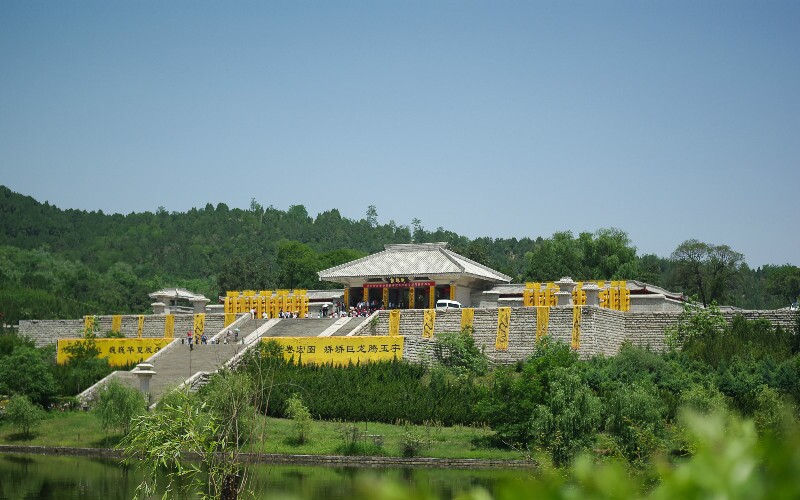
Mausoleum_Of_The_Yellow_Emperor.
Planning Your Visit: A Practical Guide
Essential Information for Your Visit to the Mausoleum of the Yellow Emperor
When you’re ready to step into the rich tapestry of Chinese history, the Mausoleum of the Yellow Emperor (黄帝陵) in Lingbao, Henan Province, is an essential stop. Revered as the burial site of Huangdi, the legendary Yellow Emperor, this site not only offers a glimpse into ancient Chinese culture but also showcases stunning natural beauty.
Location and Accessibility
- Address: Yangping Town, Lingbao 472541, China
- Nearest Major City: Zhengzhou, Henan Province
- Transportation: The mausoleum is well-connected by road. Renting a car, taking a taxi, or using public transport from nearby cities like Zhengzhou or Yanan can facilitate your visit.
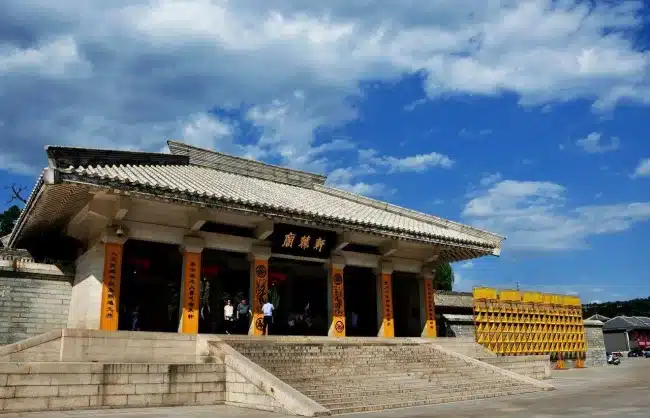
Mausoleum_Of_The_Yellow_Emperor.
Opening Hours
- Daily: 7:30 AM – 6:30 PM
- It’s advisable to arrive early to enjoy the tranquility of the site before it gets crowded.
Admission Fee
- Cost: 90 RMB per person
- Incense Burning: A small fee of 5 RMB is required if you wish to burn incense and pray for your ancestors or future generations.
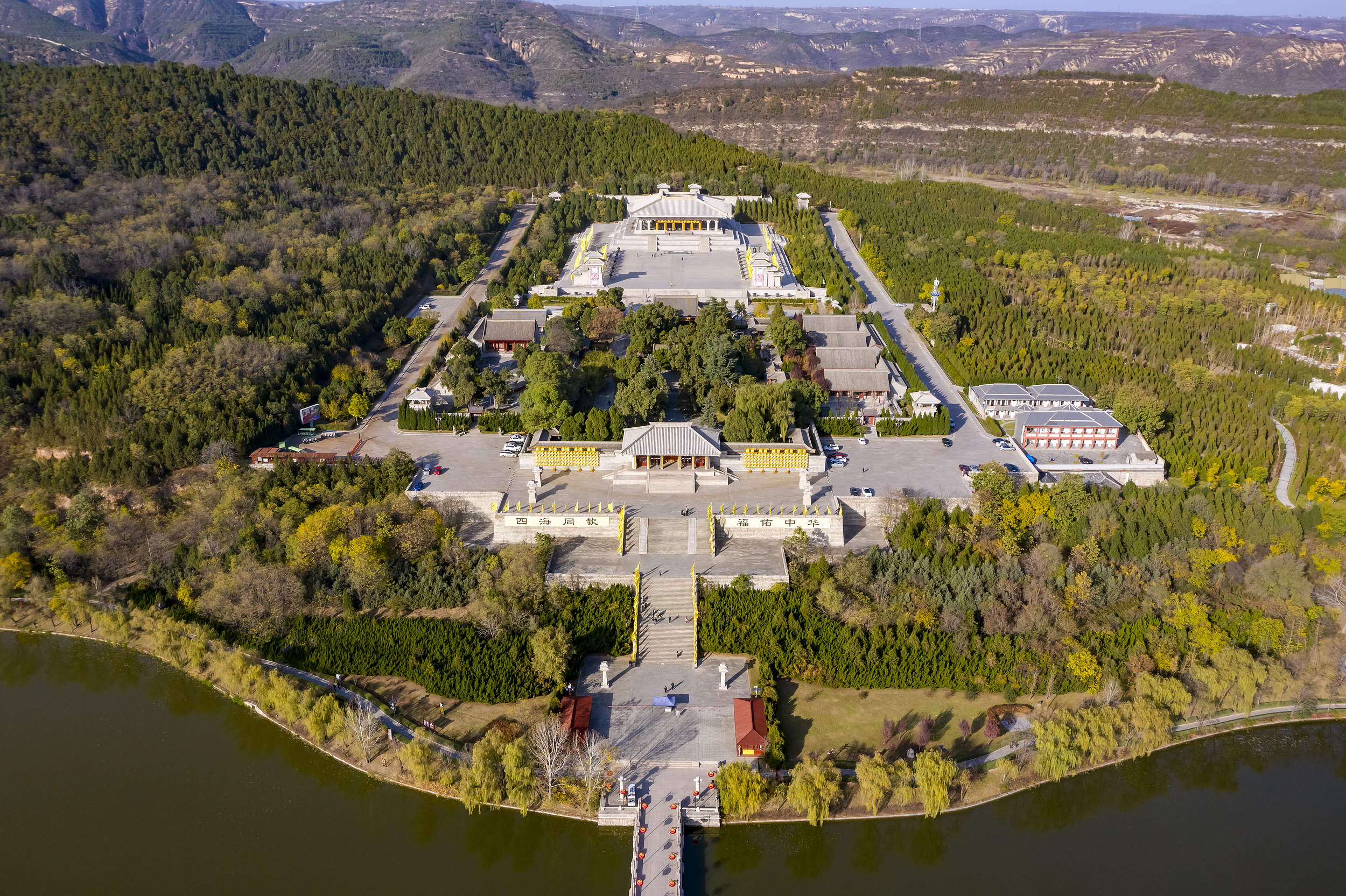
Mausoleum_Of_The_Yellow_Emperor.
What to Expect
1. The Iconic Cypress Trees
- Upon entering, you will be greeted by ancient cypress pine trees, one of which is over 5,000 years old. Legend has it that this tree was planted by the Yellow Emperor himself—an awe-inspiring sight that connects you to the past.
2. The Mausoleum Structure
- The mausoleum features a modern architectural style reminiscent of the Pantheon in Rome and grand buildings in Berlin. Its minimalist design emphasizes spaciousness and historical reverence, with a notable 6-meter stone stele that depicts the Emperor.
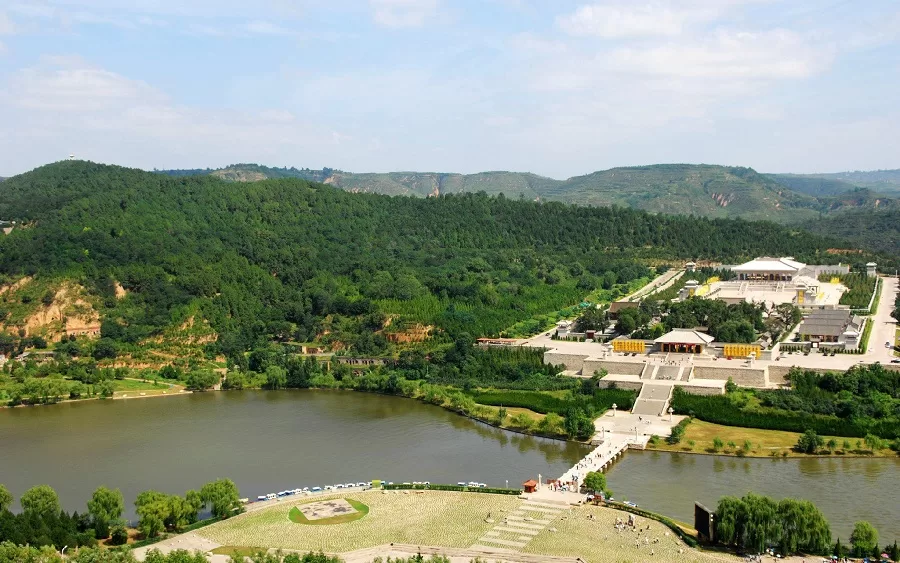
Mausoleum_Of_The_Yellow_Emperor.
3. The Courtyard
- The entry courtyard is expansive, rivaling the grand courtyards of Beijing’s Forbidden City. Set atop a hill with breathtaking views, this area is adorned with metal urns and yellow flags, enhancing the ancient atmosphere.
4. Cultural Insights
- A pavilion within the grounds houses poetry by the Yellow Emperor and Mao Zedong, highlighting the site’s significance in contemporary Chinese culture and the search for national roots.
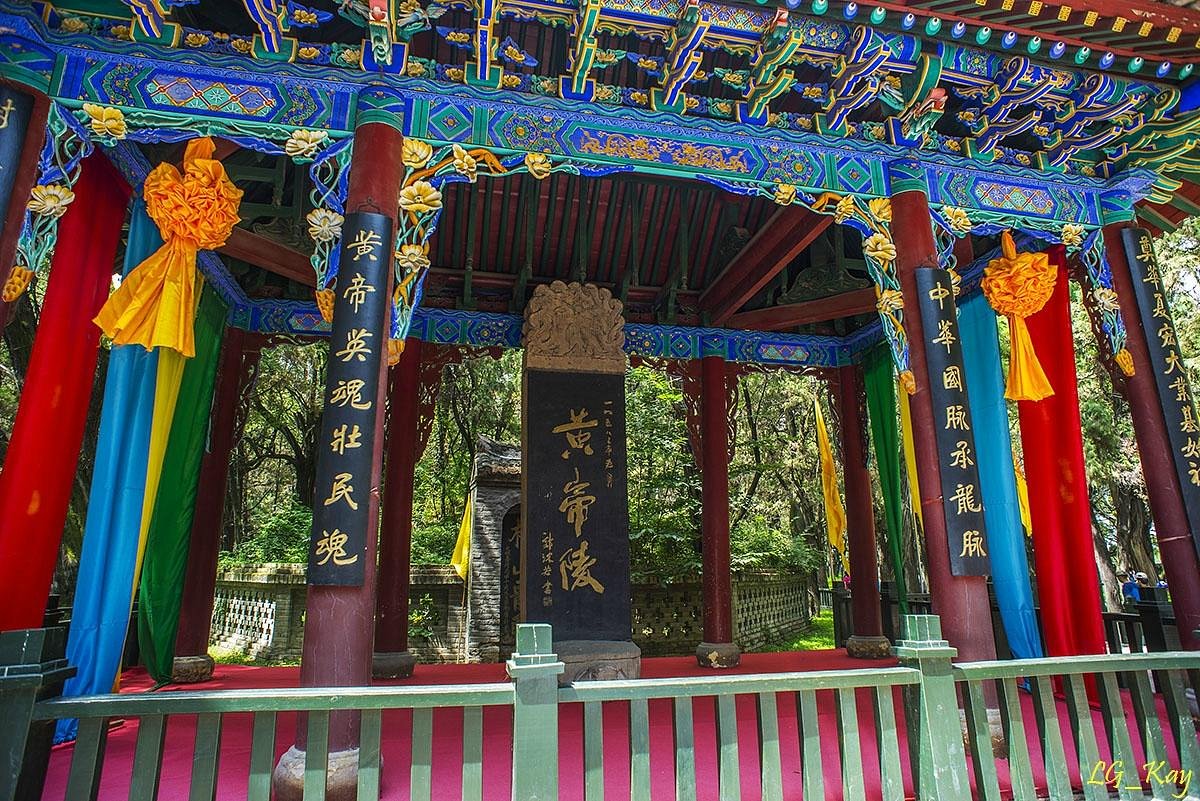
Mausoleum_Of_The_Yellow_Emperor.
5. Incense and Offerings
- You have the option to purchase incense and make offerings at the pavilion. However, be cautious of vendors who may try to sell you additional items under the guise of blessings for your family.
Tips for a Pleasant Experience
- Take an Electric Car: If you prefer to avoid a 15-minute climb to the tomb entrance, consider taking the electric car service (additional fee applies).
- Be Wary of Vendors: Vendors may be persistent. If you’re not interested in their wares, it’s perfectly acceptable to ignore them.
- Allocate Time: Plan to spend at least a few hours to fully appreciate the site’s beauty and its historical context. The tranquil lakes and broader grounds are perfect for a leisurely stroll.
Nearby Attractions
After exploring the mausoleum, consider visiting nearby attractions, such as:
– Kukou Waterfall: A scenic stop on your journey.
– Dinghu Lake Reed Marshes: Ideal for nature lovers and photography enthusiasts.

Mausoleum_Of_The_Yellow_Emperor.
Final Thoughts
Visiting the Mausoleum of the Yellow Emperor is more than just a historical excursion; it is an opportunity to connect with the profound cultural heritage of China. The serene environment, coupled with the majesty of the site, offers a reflective experience that resonates long after your visit. Whether you are a history buff, a cultural enthusiast, or simply in search of breathtaking landscapes, this site promises to leave a lasting impression.
Tickets: Prices, Booking, and Tips
Exploring the Mausoleum of the Yellow Emperor: Ticket Information and Tips
Visiting the Mausoleum of the Yellow Emperor (黄帝陵) is a journey steeped in history and cultural significance. Nestled in Lingbao, Henan Province, this site offers a unique glimpse into China’s ancient heritage. Here’s everything you need to know about tickets, booking, and some helpful tips for your visit.
Ticket Prices
- Entry Fee: The standard ticket price for adults is 90 RMB. This fee grants you access to the mausoleum, its impressive courtyards, and the surrounding grounds.
- Electric Car Fee: To reach the tomb entrance, you will need to take an electric car, which incurs a separate fee. Be prepared to budget for this additional cost.
- Incense Burning: If you wish to participate in the traditional practice of burning incense to pray for your family’s prosperity, it costs 5 RMB. Be cautious of vendors who may attempt to upsell additional items for prayer rituals.
Booking Tickets
- On-Site Purchase: Tickets can be purchased directly at the entrance. It’s advisable to arrive early, especially on weekends and holidays, as the mausoleum is a popular destination.
- Group Tours: If you’re traveling with a group or prefer a guided experience, consider booking a tour that includes the mausoleum. Many local travel agencies offer packages that cover transportation and guided tours, which can enhance your understanding of the site’s historical context.
Visiting Hours
- The mausoleum is open daily from 7:30 AM to 6:30 PM. Plan your visit accordingly to make the most of your time there.
Tips for Your Visit
- Time Your Visit: Aim to spend at least a few hours exploring the grounds. The expansive courtyard and surrounding natural beauty deserve your attention.
- Be Wary of Vendors: While the grounds are dotted with vendors selling various items related to prayer and souvenirs, some may be persistent. Politely decline if you’re not interested, and be cautious of pricing.
- Photography: The mausoleum’s architecture and the ancient cypress trees are stunning. Capture the unique juxtaposition of the site’s historical and natural elements, but be respectful of any designated no-photography areas.
- Dress Comfortably: Given the layout of the site, wear comfortable shoes for walking. Some areas may require a bit of climbing, so dress accordingly.
- Cultural Respect: As the mausoleum is a site of reverence, maintain a respectful demeanor. Understanding the cultural significance of the Yellow Emperor can enhance your appreciation of the site.
Conclusion
The Mausoleum of the Yellow Emperor is not just a remarkable historical site; it is a testament to China’s rich cultural heritage. By planning ahead, being mindful of costs, and respecting local customs, you can ensure a memorable and enriching experience at this iconic landmark.
How to Get There: A Complete Transportation Guide
Getting to the Mausoleum of the Yellow Emperor
Visiting the Mausoleum of the Yellow Emperor (黄帝陵) is a journey steeped in Chinese history and culture, located in the serene surroundings of Lingbao, Henan Province. Below is a comprehensive guide to help you navigate your way to this historic site, ensuring you have a smooth and enjoyable experience.
By Air
If you’re coming from far away, the nearest major airport is Zhengzhou Xinzheng International Airport (CGO), located about 120 kilometers (75 miles) from the mausoleum. This airport serves several international and domestic flights:
- From Zhengzhou Airport to Lingbao:
-
Option 1: Taxi or Rideshare
The most convenient way to reach Lingbao from the airport is by taxi or rideshare service, which typically takes about 1.5 to 2 hours, depending on traffic. Expect to pay around 300-400 RMB. -
Option 2: Train
You can take a taxi or shuttle from the airport to Zhengzhou Railway Station, then catch a train to Lingbao. The train journey takes approximately 1.5 hours. Check the schedule in advance, as trains run frequently.
By Train
Lingbao is accessible via several train services, making it a convenient option for travelers already in China.
- Main Train Station: Lingbao Railway Station
- Travel Tips:
- From major cities like Beijing, Xi’an, or Wuhan, there are direct trains to Lingbao.
- Book your tickets in advance, especially during peak travel seasons, to secure your seats.
Once you arrive at Lingbao Railway Station, you can take a taxi to the mausoleum, which is about 15 kilometers away, or opt for local buses that might take you closer.
By Bus
For budget-conscious travelers, long-distance buses offer a viable option.
- Bus Services:
- Several bus companies operate routes to Lingbao from nearby cities and towns.
- Buses depart from the main bus station in your departure city; it’s wise to check the schedule ahead of time.
Upon arriving at the Lingbao Bus Station, you can take a taxi or a local bus to the mausoleum.
Local Transportation
Once you’re in Lingbao, getting to the Mausoleum of the Yellow Emperor can be done via several local transport options:
- Taxi:
-
Taxis are readily available. A ride from the city center to the mausoleum should cost around 30-50 RMB.
-
Electric Car:
-
At the entrance of the mausoleum complex, you can take an electric car (for a small additional fee) that will take you closer to the main site. Note that the final walk to the mausoleum itself requires a moderate climb of about 15 minutes.
-
Walking:
- If you’re feeling adventurous and the weather is pleasant, consider walking the distance. The scenic views along the way can enhance your experience.
Tips for a Smooth Journey
- Plan Ahead: Ensure you check the transportation schedules ahead of time, especially for trains and buses, as they can vary seasonally.
- Currency: Have some cash (RMB) on hand for local transport and entrance fees, as not all places accept credit cards.
- Entrance Fee: The entry fee to the mausoleum is approximately 90 RMB. Be prepared for additional costs if you wish to purchase incense or other offerings.
- Be Cautious of Vendors: While exploring the site, keep an eye out for persistent vendors selling various items. It’s best to keep your purchases minimal and be aware of potential scams related to incense offerings.
With this guide, you are well-equipped to embark on your journey to the Mausoleum of the Yellow Emperor, where you’ll immerse yourself in the rich heritage of one of China’s most revered historical figures. Safe travels!
Local Cuisine and Accommodation Nearby
When visiting the Mausoleum of the Yellow Emperor, you’ll find not only a deep connection to Chinese history but also an opportunity to indulge in local cuisine and comfortable accommodations nearby. Here’s a guide to enhance your experience in Lingbao.
Local Cuisine
- Huangdi Restaurant (黄帝餐厅)
-
Located just a short drive from the mausoleum, this restaurant offers a range of traditional Henan dishes that celebrate the region’s culinary heritage. Try their Braised Noodles with Pork (红烧肉面)—a comforting dish that is a local favorite.
-
Lingbao Snack Street (灵宝小吃街)
-
For a more casual dining experience, head to Lingbao’s snack street. Here, you can sample an array of street foods, such as:
- Crispy Fried Dumplings (煎饺): Perfectly golden and stuffed with savory fillings.
- Spicy Grilled Fish (香辣烤鱼): A local delicacy that will tantalize your taste buds.
- Sweet Potato Balls (地瓜球): A delightful treat that’s a favorite among locals.
-
Yuanxiang Restaurant (圆香餐厅)
- Known for its family-style dining, this restaurant features a diverse menu including Stir-fried Seasonal Vegetables (时令蔬菜) and Kung Pao Chicken (宫保鸡丁). The warm atmosphere makes it a great spot to unwind after a day of exploring.
Accommodation Nearby
- Lingbao International Hotel (灵宝国际大酒店)
-
This hotel offers modern amenities and comfortable rooms, making it an ideal choice for international travelers. Its convenient location allows easy access to the mausoleum and other local attractions. Guests rave about the friendly service and the on-site dining options.
-
Grand Skylight Hotel (大观天汇酒店)
-
Located just a short drive from the mausoleum, the Grand Skylight Hotel boasts spacious rooms and a relaxing atmosphere. With its well-equipped fitness center and complimentary breakfast, it’s perfect for travelers looking for comfort and convenience.
-
Budget Options
- Lingbao Youth Hostel (灵宝青年旅舍): A great choice for backpackers and budget-conscious travelers. This hostel offers dormitory-style accommodations and a chance to meet fellow travelers.
- Local Guesthouses: Scattered throughout the area, local guesthouses provide a more authentic experience. These often include homemade meals and a glimpse into everyday life in Lingbao.
Tips for Your Visit
- Timing: Plan your visit to the mausoleum early in the morning or late afternoon to avoid crowds and enjoy the serene atmosphere.
- Incense Offerings: If you wish to partake in the cultural practice of burning incense, be cautious of vendors and their pricing.
- Stay Hydrated: While exploring the grounds, especially during warmer months, ensure you have water on hand.
With its combination of rich history, delicious cuisine, and comfortable accommodations, the area surrounding the Mausoleum of the Yellow Emperor offers an enriching experience that complements your journey through one of China’s most significant historical sites. Enjoy your adventure in Lingbao!
Frequently Asked Questions
Common Questions About the Mausoleum of the Yellow Emperor
1. What is the Mausoleum of the Yellow Emperor?
The Mausoleum of the Yellow Emperor (黄帝陵) is a significant historical site located in Lingbao, Henan Province, China. It is dedicated to Huangdi, the Yellow Emperor, who is considered a legendary figure and a key ancestor in Chinese culture. The mausoleum complex features a grand entry courtyard, impressive architecture, and ancient cypress pine trees believed to be over 3,500 years old.
2. How much does it cost to visit?
The entrance fee to the mausoleum is 90 RMB. This price grants access to the courtyard and the surrounding grounds, which are rich in historical significance and natural beauty.
3. What are the main attractions within the mausoleum complex?
Key highlights include:
– Ancient Cypress Trees: Notably, one tree is believed to have been planted by the Yellow Emperor himself and is around 5,000 years old.
– The Mausoleum Building: The architecture is minimalist yet striking, reminiscent of the Pantheon in Rome.
– Poetry Pavilions: These feature verses from both the Yellow Emperor and Chairman Mao, reflecting the site’s cultural significance.
– A Beautiful Lake: The grounds also include a serene lake, perfect for a leisurely stroll.
4. What should I be aware of when visiting?
Visitors should be cautious of vendors selling incense and other items, as some may pressure you to make purchases at inflated prices. If you choose to burn incense as an offering (usually around 5 RMB), be mindful of potential scams where individuals might demand higher fees afterward.
5. How do I get to the mausoleum?
The mausoleum is accessible via public transport or private vehicles. Once on-site, an electric car is available for a small fee to transport visitors to the entrance of the tomb, followed by a 15-minute walk uphill to the mausoleum itself.
6. What are the opening hours?
The mausoleum is open daily from 7:30 AM to 6:30 PM, allowing ample time for visitors to explore the grounds and take in the historical atmosphere.
7. Is it suitable for families and children?
Yes, the site is family-friendly and provides educational opportunities about Chinese history and culture. However, families should supervise children closely, especially around vendors and while hiking to the tomb.
8. How much time should I plan for my visit?
Plan to spend at least two to three hours exploring the mausoleum and its grounds. This allows time to appreciate the architecture, enjoy the natural beauty, and visit the various pavilions without feeling rushed.
Final Thoughts on Your Trip
As your journey to the Mausoleum of the Yellow Emperor comes to a close, take a moment to reflect on the rich tapestry of history and culture that this sacred site embodies.
Embracing the Legacy
Visiting the mausoleum is not just a step back in time; it is an invitation to connect with the very roots of Chinese civilization. The Yellow Emperor, often regarded as the “Father of the Chinese Nation,” symbolizes unity and the enduring spirit of the Chinese people. Standing amidst the towering cypress trees, some over 5,000 years old, you grasp the profound sense of history that envelopes this place.
Architectural Marvels
The mausoleum’s architecture, while modern, draws inspiration from ancient designs, echoing the grandeur of historical monuments around the world. The spacious courtyard, free from walls and nestled among distant hills, offers an expansive view that evokes feelings of openness and freedom, a stark contrast to the enclosed spaces of more famous sites like the Forbidden City.
A Personal Connection
Whether you choose to burn incense and pray for your family’s prosperity or simply wander the serene grounds surrounding the beautiful lake, each moment spent here allows you to forge a personal connection with the past. Just be mindful of the local vendors, as their persistence can be overwhelming; focus instead on the tranquility that this sacred site offers.
Final Thoughts
As you leave the Mausoleum of the Yellow Emperor, carry with you the wisdom of history and the spirit of resilience that it represents. It is a reminder that every journey is not just about discovering new places, but also about understanding the narratives that shape our shared human experience. Make it a point to revisit the stories and traditions that resonate within you, ensuring that the legacy of the Yellow Emperor continues to inspire future generations.
This unique blend of ancient history and natural beauty makes the mausoleum not just a destination, but a memorable chapter in your travel journey through China. Safe travels as you continue to explore the wonders of this remarkable country!